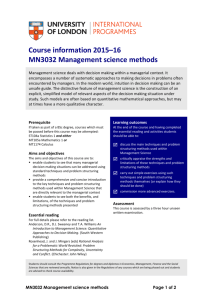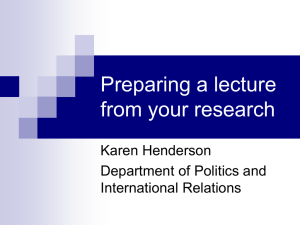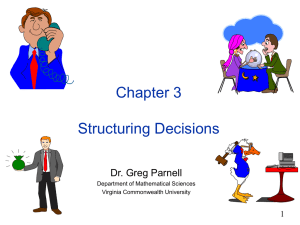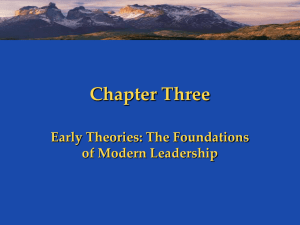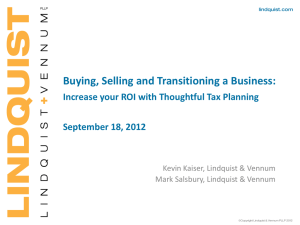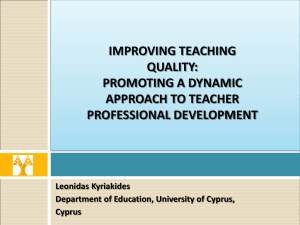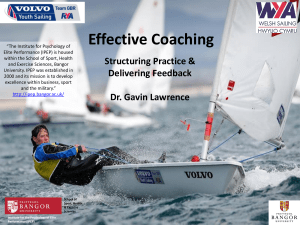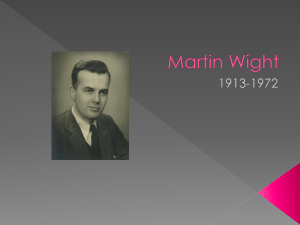PPT
advertisement
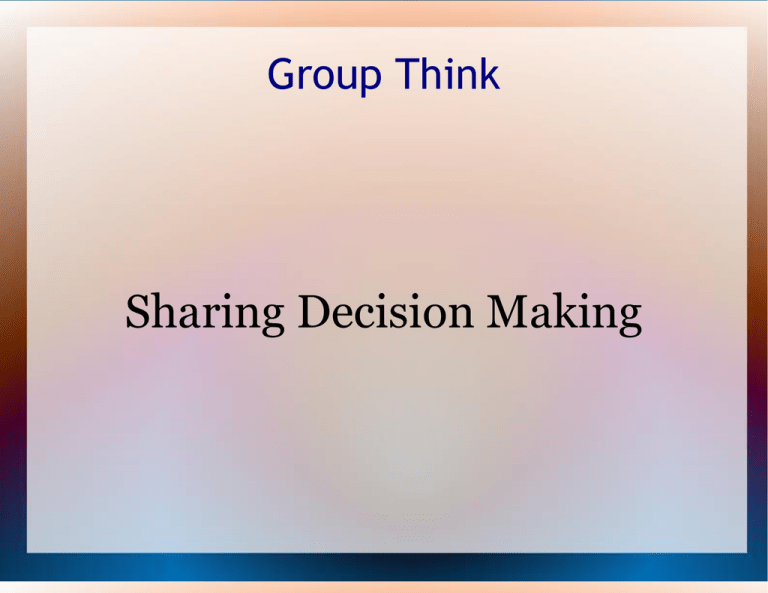
Group Think Sharing Decision Making Problems with Groups Governing Values ● Win, don't lose ➢ ● Maintain control ➢ ● Don't listen–someone may disprove your POV Brainstorming may lead in unanticipated and uncomfortable directions Avoid Embarrassment and Stay Rational ➢ Revealing POV and logic may expose you to ridicule or negative criticism Leader Effectiveness Training ● Problem solving steps: 1. identify and define the problem 2. generate alternative solutions 3. evaluate alternative solutions 4. decision making 5. implementing the decision 6. follow up to evaluate the solution ● However, the process is a bit fuzzy. Success is all in the ego-less active listening. Group Decision Making ● Four negative outcomes ● No consensus ➢ Problem not sufficiently engaged ➢ Postpone making a decision ➢ Suffer whatever costs accrue from delay Group Decision Making ● Bad consensus “Groupthink” ➢ ➢ ➢ Poor decision: does not make full use of members' logic and data Over-responsible member's views prevail Under-responsible member's views ignored or suppressed, they retreat and watch. ➢ Due to conformity pressures, ➢ Fear of conflict, ➢ Anxiety: fear of rejection, abandonment Group Decision Making ● False consensus ➢ ➢ Group appears to reach a choice Under-responsible members have not voiced their opposition ➢ Silent parties resist taking action, ➢ Subsequently undermine the choice, ➢ In the future, ask to revisit the choice. ➢ We kid ourselves that we agreed. Group Decision Making ● Weak consensus ➢ Path of least resistance ➢ Directive to make a decision quickly ➢ ➢ The choice has minimal enthusiasm or commitment Choice is unwound or reversed at the first sign of trouble The Choice Structuring Process ● Produces robust and compelling choices ➢ ➢ ➢ Sound logic applied to valid, representative data Logic and data subject to thorough and open testing Representative data comes from all relevant group members ● Without violating Governing Values ● Without triggering Responsibility Virus Reframing Existing Frame ● ● ● I know the right answer Other is uninformed or illintentioned Task: Get them to see things my way Altered Frame I have a wealth of experience but I may not see or understand everything Other may see things I don't see which may contribute to my understanding Use our collective talents to make the best choice How we reason (Kathryn Schulz) ● Humans use inductive reasoning ➢ ➢ ➢ From the particular to the general Pattern recognition used to learn language, organize the world into meaningful categories, and grasp the relationship between cause and effect conclusions are not necessarily true, but they are probably true. ➢ It's fast, effective, subjective but agreeable. ➢ “The giraffe had a very long ____.” How we reason (Martin) ● ● Sally and Richard had a meeting with a customer Customer: “I really like VisionTech. It has been an innovative leader for a long time. But I'm coming under increasing pressure and have to make tradeoffs.” Ladder of Inference (Martin/Argyris) ● Sally selects her data: ➢ ➢ ● “I really like VisionTech. It has been an innovative leader for a long time.” Didn't take notes. Can't remember everything. (It's what I want to hear.) Make sense of data: ➢ What is the particular observation here? ➢ customer values our leadership and innovation Ladder of Inference (Martin/Argyris) ● ● Sally names (categorizes) her data: ➢ From particular observation to general pattern ➢ customers value leadership and innovation Understand / evaluate: ➢ ➢ ● Induction to Intuition customers will stick with us if we continue to lead and innovate Decision for success: ➢ leadership and innovation are most critical Ladder of Inference (Martin/Argyris) ● Richard selects his data: ➢ ➢ ● “But I'm coming under increasing pressure and have to make tradeoffs.” Didn't take notes. Can't remember everything. (It's what I want to hear.) Make sense of data: ➢ ➢ What is the particular observation here? customer will make tradeoff against us because of cost pressure Ladder of Inference (Martin/Argyris) ● ● Richard names (categorizes) his data: ➢ From particular observation to general pattern ➢ customers are feeling intense cost pressure Understand / evaluate: ➢ ➢ ● Induction to Intuition customers will migrate away from us due to their cost concerns and our pricing Decision for success: ➢ Reduce our costs to be more price competitive Ladder of Inference (Martin/Argyris) ● When Sally and Richard meet... ● Sally says we need more R&D ● ● ● Richard says we need a more efficient supply chain The other one “simply doesn't get it” Governing Values push to them to withdraw rather than risk an embarrassing or defeating challenge to their data and logic. How bad news travels up Our development process is a ● venture of creativity (the CEO was told) ● undertaking of new ideas (the VP heard) ● collective of stimulated germination ● accumulation of forceful fertilizer ● raised mass of powerful manure ● mound of strong smelling crap ● pile of stinking shite (the developer said) Group Process Principles ● We all Win, No one Loses ➢ Disassociate options from individuals ➢ Options up for discussion are owned by group ➢ Conflicting positions resolved based on testing data and logic. Group Process Principles ● Maintain Control ➢ ➢ ● When supporting an option, individual can affect how the option is considered by others When opposing an option, individual can set the test for the option and the standard of proof for the test Avoid embarrassment ➢ Disassociate options from individuals ➢ Draw out all options, even if outlandish Group Process Principles ● Stay rational ➢ ● A logical, not emotional, reason for including every option The process inoculates against downsides of Governing Values Brainstorming ● ● Brainstorming as originally defined by Alex Osborn in 1953 effective at generating lots of ideas... Just not quality ideas Brainstorming For quality ideas: 1. Individual thought and generation 2. (Anonymous) posting of ideas to wiki or other social collaboration 3. Verbal and text discussion posted while allowing further posting of ideas ➢ ➢ Further posting avoids queuing/waiting to speak and thus forgetting. Posting allows everyone to catch up. Choice Structuring Process ● What is the issue? 1. Frame Choice Options ● convert issue into at least two mutually independent options that might resolve the issue ➢ Choice is an irreversible commitment ➢ Group must understand consequences ➢ Any member can add an option to choice set Choice Structuring Process 2. Brainstorm Possible Options ● ● ● Option told in the form of a story describing a positive outcome. Story has internal consistency in its logic Does not need to be proven at this point as long as it could be valid ● Story tells why an option could make sense ● Easier to understand than data and logic Choice Structuring Process 3. Specify Conditions ● ● ● ● What conditions must be substantiated to believe that the story is sound? Reverse engineer from an assumed valid conclusion to the logic and data that would have to hold true. Not whether the conditions are true Just what would have to be true Done by the group, not the individual who raised the option Choice Structuring Process 3. Specify Conditions ● ● ● Those with reservations speak out. If the conditions survive the test, public validation will generate commitment. If the conditions are invalidated, the option has been fairly considered and failed on its merits (not because anyone was wrong) Choice Structuring Process 4. Identify Barriers to Choice ● ● What conditions from step 3. are least likely to hold true? Skeptical members are taken seriously Choice Structuring Process 5. Design Valid Tests ● ● ● ● Key barrier conditions are tested in ways the entire group will find compelling Group must regard test as valid Most skeptical member is critical for test design. They will have highest standard of proof for the test. May be multiple tests for a condition Choice Structuring Process 5. Design Valid Tests ● Tests enable each member to believe in the choice, commit to it, and take action if the analysis confirms the condition Choice Structuring Process 6. Conduct Analysis ● ● ● ● Do analysis prescribed by test design Most expensive and time-consuming part of choice process Test conditions in reverse order of group's confidence. It quickly eliminates options and other tests for those options. Skeptical member oversees the analysis Choice Structuring Process 6. Conduct Analysis ● ● Skeptic sees that test is done with rigorous standards If skeptic says the condition is confirmed, group will find the result compelling Choice Structuring Process 7. Make the Choice ● ● ● ● Group has a shared understanding of logic and data supporting each option Group has designed tests for each condition acting as a barrier to choice Most skeptical member has set standard of proof and has overseen the analysis Group reviews test results and makes the often obvious choice. Choice Structuring Process ● ● ● ● The process is about suggesting any option that presents a clear choice of action. Only positive conditions are proposed to support the option. Conditions are tested by the most skeptical. If the option is set aside, it is not the option that was bad but the condition to support it was not present.
